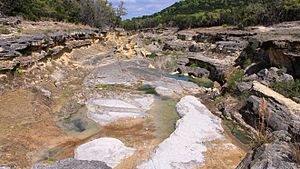Canyon Lake Gorge facts for kids
Canyon Lake Gorge is a special place in Texas. It's a deep cut in the ground, like a small gorge, made of limestone rock. It's about 1 mile (1.6 km) long and up to 50 feet (15 m) deep. This amazing gorge was created very quickly in 2002.
That year, a huge flood on the Guadalupe River caused a lot of water to flow over the spillway of Canyon Lake. This powerful water washed away dirt and rock, revealing the gorge. Inside, you can see rock layers that are 111 million years old! These layers show fossils and even dinosaur footprints. The gorge is also a new home for animals, with carp fish and other creatures living in its pools and waterfalls.
A group called the Gorge Preservation Society works with the Guadalupe-Blanco River Authority and the U.S. Army Corps of Engineers to protect the gorge. You can visit the gorge on special guided tours. These tours are about three hours long. Remember, you can't bring pets, and you can't collect rocks or fossils. Scientists can get special permits to study the area.
The Big Flood of 2002
In July 2002, a massive flood hit the area. For about six weeks, an incredible amount of water flowed over the spillway of Canyon Lake. This was the first time the spillway had been used since the dam was built in 1964. Normally, much less water flows out of the lake.
The Guadalupe River area is known for "Flash Flood Alley." This means it's one of the places in the world most likely to have sudden, powerful floods. The 2002 flood was very strong. It damaged or destroyed 48,000 homes and cost about $1 billion. Even though the water went over the spillway, the dam still helped prevent about $38.6 million in damages further downstream.
A Place for Learning and Nature
On November 29, 2005, an important agreement was signed. The Guadalupe-Blanco River Authority and the U.S. Army Corps of Engineers agreed to develop Canyon Lake Gorge. Their goal is to make it a valuable place for education and to protect its natural beauty.
How the Gorge Helps Geologists
The sudden creation of Canyon Lake Gorge in 2002 gave scientists a rare chance. They could study how quickly powerful water can shape the land. This helps them understand how canyons form.
In 2010, scientists Michael Lamb and Mark Fonstad studied the gorge. They showed how a part of the Guadalupe River Valley changed into a steep-walled canyon in just three days. The flood carved out the limestone rock, making the gorge over 20 feet (6 m) deep and 130–200 feet (40–61 m) wide for more than a mile.
The powerful water pulled huge boulders from the ground. This created several waterfalls, smaller channels, and flat rock areas called terraces. The water, full of sediment, also smoothed the walls and made deep holes called plunge pools.
Usually, scientists thought that steep, narrow gorges formed very slowly over a long time. But Canyon Lake Gorge shows that some amazing canyons on Earth might have been carved quickly by ancient, huge floods. Because we know the exact flood conditions that created this gorge, it helps scientists make better computer models. These models can help them figure out how big prehistoric floods were and how fast they eroded the land.



